Indoor plants bring life, color, and freshness to any space. But as time passes, their leaves can collect dust, grime, and residue from the surrounding environment. What many plant owners don’t realize is that this thin layer of dirt does more than just dull the shine of your foliage — it can actually hinder plant health and slow growth.
Cleaning plant leaves might sound like a small detail, but it’s one of the most powerful ways to keep your indoor garden thriving. In this detailed guide, you’ll learn why leaf cleaning is essential, what benefits it offers, and how to do it safely and effectively — the natural way.
1. Why Leaf Cleaning Matters More Than You Think
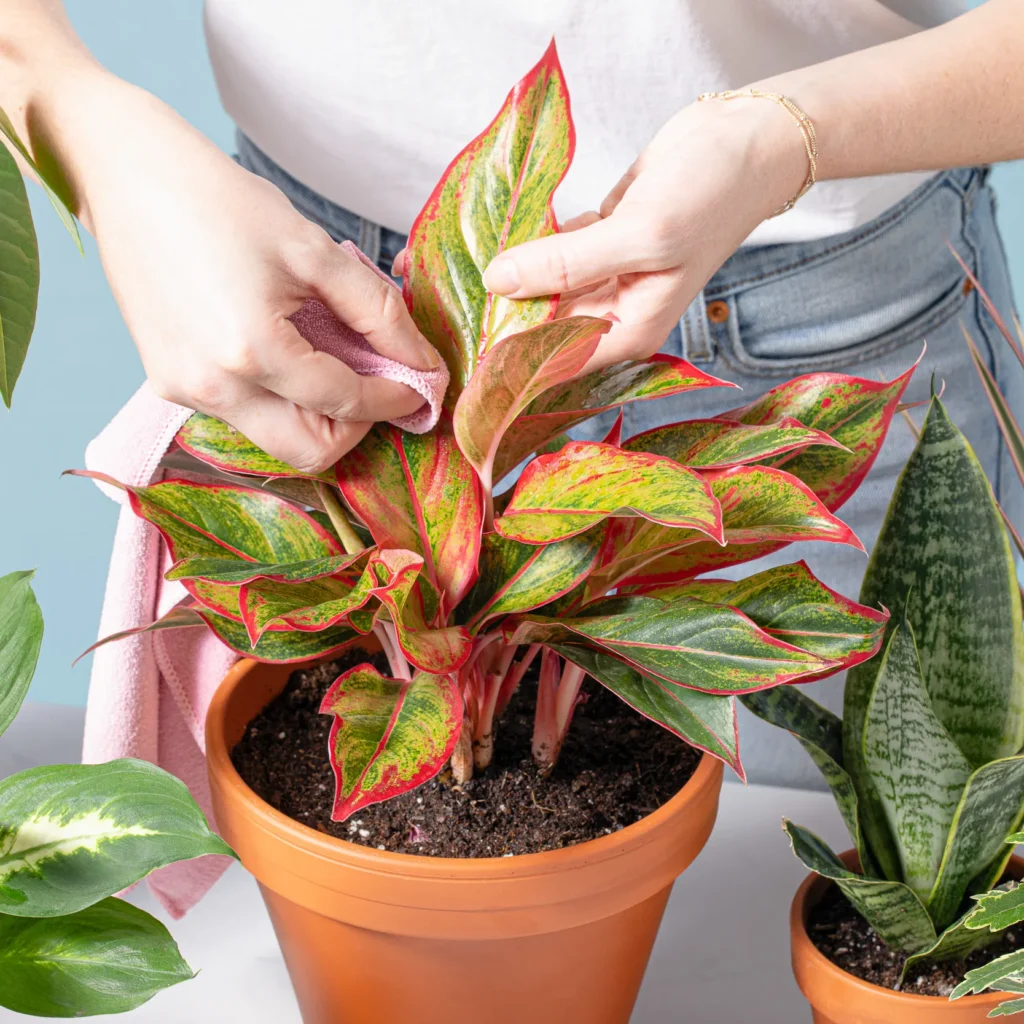
Just like humans need clear skin to breathe, plants need clean leaves to “breathe” and function properly. The tiny openings on a leaf’s surface, called stomata, are crucial for photosynthesis, transpiration, and gas exchange. When these pores are clogged by dust and debris, the plant’s overall health declines.
Here’s what happens when you don’t wipe your plant leaves regularly:
- Reduced Photosynthesis: Dust blocks sunlight, which plants need to convert light into energy. Less light means slower growth and duller foliage.
- Clogged Pores: Stomata get blocked, making it difficult for the plant to “breathe” and regulate water.
- Increased Pest Risk: Dusty leaves attract pests like spider mites and aphids that thrive in dirty environments.
- Lower Humidity Absorption: Plants also absorb moisture through their leaves — a layer of grime can prevent this.
- Unhealthy Appearance: Dirty leaves lose their natural shine and color, making your indoor space look neglected.
Simply put, cleaning leaves is more than a cosmetic task — it’s part of essential plant care.
2. The Benefits of Wiping Plant Leaves Regularly
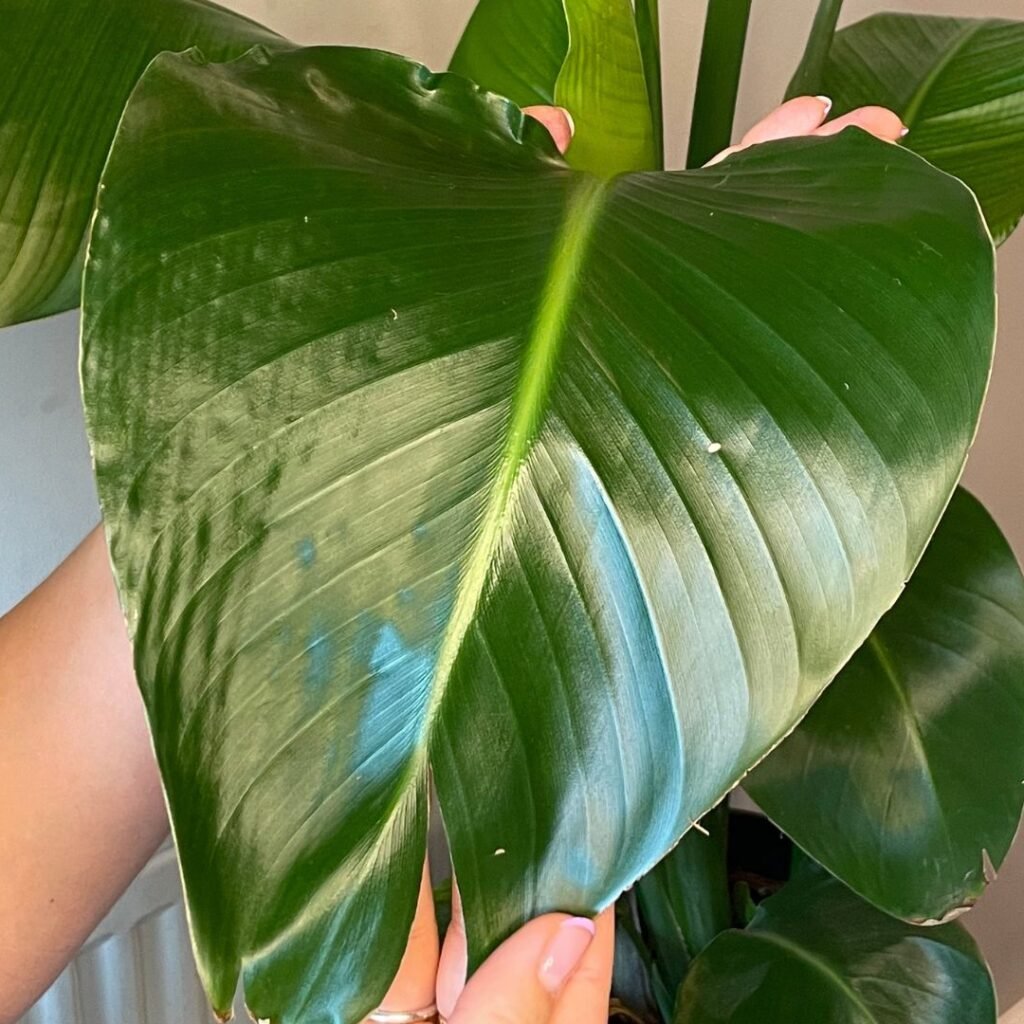
Regularly cleaning your plant leaves improves both their health and aesthetic appeal. Let’s explore the major benefits in detail:
a) Boosts Photosynthesis
When you remove dust, you allow maximum light to reach the leaf surface. More light means stronger, greener, and faster-growing plants.
b) Enhances Air Quality
Clean leaves absorb carbon dioxide more efficiently and release more oxygen, helping purify the air in your home naturally.
c) Prevents Pest Infestations
Pests love dirty environments. By keeping your plants clean, you discourage common intruders like mites, whiteflies, and mealybugs.
d) Improves Aesthetic Value
Shiny, vibrant leaves look healthier and instantly make any room feel more alive and well cared for.
e) Reduces Fungal and Mold Growth
Dust and residue can trap moisture, leading to mold or mildew on the leaf surface. Cleaning prevents these issues before they start.
f) Promotes Longevity
A clean leaf system helps your plant breathe and function better, extending its lifespan.
3. How Often Should You Clean Plant Leaves?
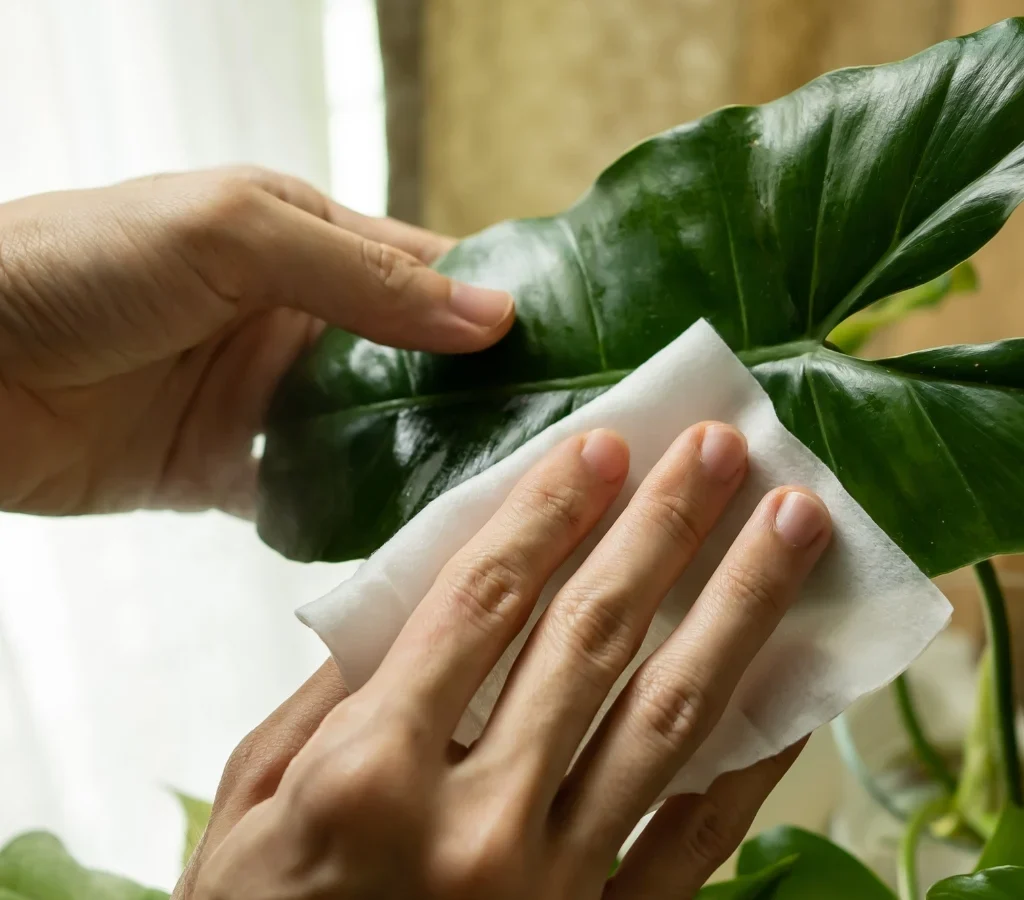
The ideal cleaning frequency depends on your environment and the type of plant.
- In urban or dusty areas: Wipe leaves every 7–10 days.
- In less dusty homes: Every 2–3 weeks is sufficient.
- For large collections: Rotate cleaning days — a few plants at a time.
A simple test: if you run your finger along a leaf and it leaves a visible dust mark, it’s time for a cleaning session.
4. The Right Way to Wipe Plant Leaves — Step-by-Step
Cleaning leaves the wrong way can actually harm your plants. Follow these gentle, natural steps to keep your indoor greenery spotless and safe.
Step 1: Gather the Right Supplies
You don’t need fancy tools — just the basics:
- Soft microfiber cloth or a clean sponge
- Spray bottle with lukewarm water
- Mild natural soap (optional)
- Small soft brush (for hairy or textured leaves)
- Bowl or bucket for water
Avoid using chemical leaf polishers or oils — they can clog pores and attract more dust.
Step 2: Dust the Leaves First
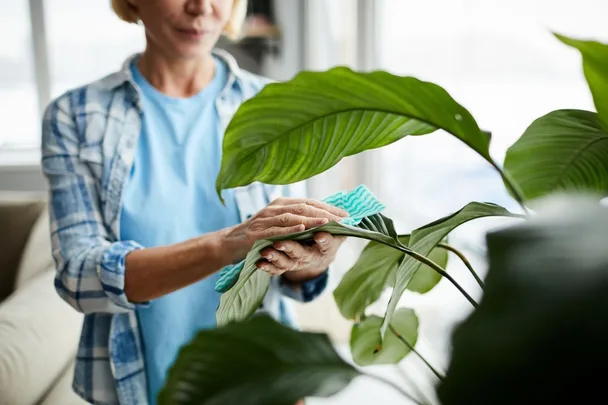
Start by dusting the leaves dry before using water. Use a soft brush or microfiber cloth to gently remove loose dust. Always support the leaf from underneath with one hand to avoid snapping delicate stems.
For plants with fine leaves (like ferns or asparagus plants), use a small paintbrush or makeup brush.
Step 3: Prepare a Gentle Cleaning Solution
For tough grime or sticky residue, mix a simple natural cleaning solution:
- 1 quart (1 liter) of lukewarm water
- A few drops of mild liquid soap (like castile or baby soap)
Avoid strong detergents, alcohol, or vinegar — they can damage leaf tissue.
Step 4: Wipe Each Leaf Carefully
- Dip your cloth or sponge in the cleaning solution and wring it out so it’s damp, not dripping.
- Gently wipe the top and underside of each leaf. The underside is especially important — that’s where pests hide and stomata are located.
- Rinse the cloth regularly to avoid spreading dust back onto the leaves.
Tip: Always wipe in the direction of the leaf’s veins to prevent tearing.
Step 5: Rinse (If Necessary)
If your plant has many leaves or large foliage (like Monstera or Rubber Plant), you can give it a gentle rinse under a lukewarm shower or spray. Let excess water drain thoroughly afterward to avoid waterlogging.
Step 6: Let the Leaves Dry Naturally
After cleaning, allow the leaves to air-dry in a shaded spot with good airflow. Avoid direct sunlight — wet leaves can burn easily under strong light.
5. Special Cleaning Techniques for Different Types of Plants
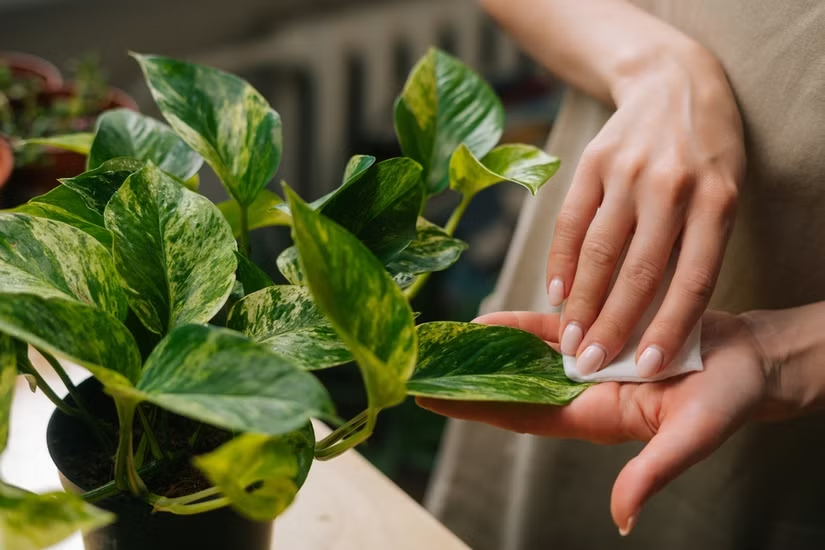
Not all plants can be cleaned the same way. Their leaf type determines the safest cleaning method.
a) Smooth, Broad Leaves (e.g., Monstera, Rubber Plant, Peace Lily)
- Use a soft cloth and gentle wiping method.
- Clean both sides carefully — these plants collect the most dust.
b) Fuzzy or Hairy Leaves (e.g., African Violet, Begonia Rex)
- Never use water directly — it can cause leaf spots and rot.
- Use a soft brush to dust off dirt gently.
- If needed, use a slightly damp brush tip to remove stubborn grime.
c) Delicate or Small Leaves (e.g., Ferns, Asparagus Fern, Maidenhair Fern)
- Misting works best. Use filtered water to remove light dust.
- Avoid wiping, as fronds are fragile and can break easily.
d) Succulents and Cacti
- These plants gather dust too, but their waxy or spiny surfaces make them tricky.
- Use a soft brush or compressed air to remove dust between ridges.
6. Natural Ingredients That Help Shine and Clean Leaves
Instead of store-bought leaf shine sprays, try these natural and safe alternatives that clean and add gentle luster:
- Banana Peel Wipe: Rub the inside of a banana peel gently on broad leaves, then wipe with a soft cloth for a natural shine.
- Aloe Vera Solution: Mix 1 tablespoon of aloe gel in 1 liter of water and wipe — adds a healthy glow and mild antifungal protection.
- Neem Oil Spray: A few drops mixed in water help clean leaves and deter pests naturally.
- Green Tea Solution: Mild green tea can remove sticky residue and add a gentle sheen.
Always test any natural cleaner on a single leaf first to ensure no damage occurs.
7. Mistakes to Avoid When Cleaning Plant Leaves
Even with good intentions, many plant lovers make mistakes that can harm their greenery. Avoid these common errors:
- ❌ Using commercial leaf shine products — they clog pores and attract dust.
- ❌ Spraying plants in direct sunlight — can cause sunburn or leaf spots.
- ❌ Using cold or hot water — extremes shock the plant and damage tissues.
- ❌ Forgetting the underside of leaves — that’s where stomata and pests hide.
- ❌ Cleaning too aggressively — can tear leaves or bruise them.
8. How to Keep Leaves Clean for Longer
After cleaning, you can take steps to reduce how quickly your plants get dusty again:
- Keep windows and air vents clean to minimize dust circulation.
- Wipe nearby surfaces — dust settles from furniture to leaves.
- Use an air purifier to reduce indoor particles.
- Maintain humidity levels — higher humidity helps prevent dust buildup.
- Regularly mist your plants to keep them hydrated and fresh-looking.
These simple habits keep your plants glowing between cleaning sessions.
9. The Emotional and Aesthetic Rewards
Beyond plant health, cleaning leaves regularly can be therapeutic. It gives you a chance to slow down, observe your plants closely, and spot early signs of trouble like pests or nutrient deficiencies.
Watching the leaves regain their rich color and shine also offers a sense of satisfaction — your plants look happier, and your space feels cleaner and more vibrant.
A well-maintained indoor plant doesn’t just grow better; it uplifts the entire atmosphere of your home.
10. Conclusion
Wiping plant leaves regularly might seem like a small act, but it’s one of the most impactful things you can do for your indoor garden. Clean leaves mean more light absorption, better respiration, and stronger growth — all of which contribute to a lush, thriving, and radiant indoor environment.
By using gentle, natural cleaning methods and making it a consistent part of your plant care routine, you’ll help your plants stay healthy and beautiful for years to come.
So next time you notice a thin layer of dust dulling your plant’s glow, take a soft cloth, some water, and a few quiet minutes. Your plants — and your indoor space — will thank you with fresh, glossy leaves and vibrant energy all around.
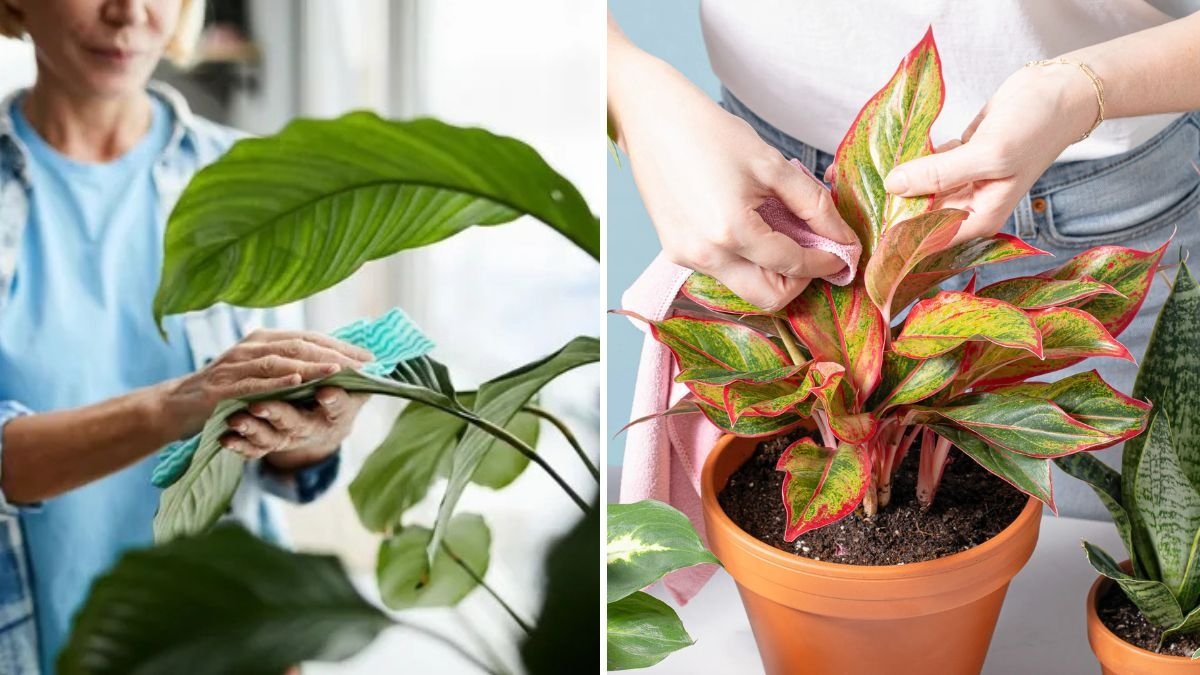




Leave A Comment